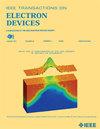Comprehensive Optimization Strategies for InSnZnO Grade-Channel Thin-Film Transistors via Atomic Layer Deposition
IF 2.9
2区 工程技术
Q2 ENGINEERING, ELECTRICAL & ELECTRONIC
引用次数: 0
Abstract
The amorphous oxide semiconductors (AOSs) have been widely explored for thin-film transistors (TFTs). However, a tradeoff persists between high field-effect mobility and low threshold voltage attributed to percolation conduction, necessitating comprehensive optimization. Herein, the grade-channel InSnZnO (ITZO) TFTs with enhanced performance synthesized by atomic layer deposition (ALD) were investigated by the stoichio-metric and structure optimization in channel. The relationship between stoichiometric of channel and electrical transport property has been investigated in single-layer-channel ITZO TFTs. Then, we investigated the influence of vertical stoichiometric distribution on performance enhancement in bilayer-channel and grade-channel ITZO TFTs. The ITZO TFTs based on grade channel exhibit superior characteristics, including remarkable mobility of 65.88 cm2/V求助全文
约1分钟内获得全文
求助全文
来源期刊

IEEE Transactions on Electron Devices
工程技术-工程:电子与电气
CiteScore
5.80
自引率
16.10%
发文量
937
审稿时长
3.8 months
期刊介绍:
IEEE Transactions on Electron Devices publishes original and significant contributions relating to the theory, modeling, design, performance and reliability of electron and ion integrated circuit devices and interconnects, involving insulators, metals, organic materials, micro-plasmas, semiconductors, quantum-effect structures, vacuum devices, and emerging materials with applications in bioelectronics, biomedical electronics, computation, communications, displays, microelectromechanics, imaging, micro-actuators, nanoelectronics, optoelectronics, photovoltaics, power ICs and micro-sensors. Tutorial and review papers on these subjects are also published and occasional special issues appear to present a collection of papers which treat particular areas in more depth and breadth.
 求助内容:
求助内容: 应助结果提醒方式:
应助结果提醒方式:


